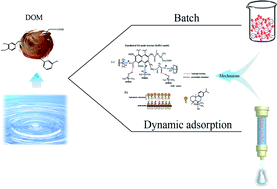Performance of a zeolite modified with N,N-dimethyl dehydroabietylamine oxide (DAAO) for adsorption of humic acid assessed in batch and fixed bed columns†
Abstract
Factors that affect adsorption of a synthetic humic acid (HA) on a zeolite modified with the surfactant N,N-dimethyl dehydroabietylamine oxide (DAAO) (SMZ) were investigated in batch and fixed bed column experiments. Adsorption increased with increasing HA concentrations and contact time, but decreased with increasing pH, temperature, and ionic strength. Adsorption of HA on SMZ was increased by the presence of the cations Ca2+ and Mg2+, whereas anions such as NO3−, HCO3−, SO42−, and PO43− showed the opposite trend, and competed with HA adsorption. HA adsorption on SMZ was well-fitted by pseudo-second order kinetics, and described by the Langmuir isotherm model. The maximum adsorption capacity in batch experiments calculated from the Langmuir adsorption isotherm was about 126 mg g−1. Thermodynamic calculations showed that HA adsorption on the zeolite with bilayer DAAO coverage was spontaneous and exothermic. Optimum desorption was obtained using 0.1 M NaOH with a recovery of 94%. The HA adsorption capacity of SMZ at the breakthrough point was greatly influenced by bed depth, and could be described by the Thomas model. Adsorption mechanisms are interpreted as involving mainly hydrogen bonding and electrostatic interactions.



 Please wait while we load your content...
Please wait while we load your content...